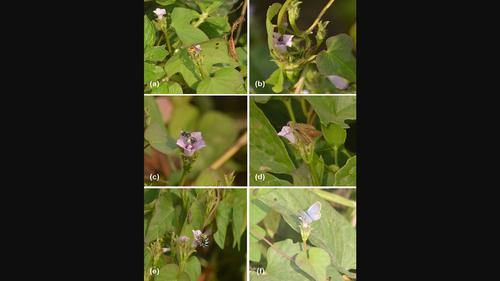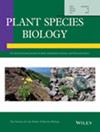Reproductive biology and pollination ecology of Ipomoea triloba L. (Convolvulaceae): An alien invasive species of the Indo-Burma biodiversity hotspot
IF 1.3
4区 生物学
Q4 ECOLOGY
引用次数: 0
Abstract
Ipomoea triloba L., an annual twining herb, is considered an alien invasive species and is distributed all around the globe including tropical Asia. It affects the yield of various economically important crops. Studies on floral phenology and reproductive biology are fundamental for the development of management strategies and the conservation of plants. Hence, we investigated the phenology, floral biology, pollen viability, stigma receptivity, pollination mechanism, and reproductive success of I. triloba at two different locations in one of the global biodiversity hotspots. Floral anthesis was diurnal, starting at 6:30 a.m. and lasting until 7:00 a.m. Pollen viability and stigma receptivity were found to coincide, thus suggesting the species was homogamous. The flowers were mostly visited and pollinated by sweat bees (Halictidae), blue-banded bees (Amegilla sp.), flies (Mesembrius sp.), and butterflies (Appias olferna, Pelopidas agna, and Zizina otis). Further, the pollinator visitation frequency showed a moderately positive correlation with the number of open flowers in both study populations. The plant produced fruits in the absence of pollinators in self-pollination treatments, indicating a self-compatible breeding system and dependency on insect pollination for reproductive success. Further, pollen supplementation significantly enhanced the fruit setting and mean seed per fruit at both study sites, suggesting pollen limitation. Additionally, pollen production and pollen/ovule ratio also indicated the facultative autogamous breeding system in I. triloba. Overall, these reproductive characteristics such as mixed mating systems and generalist insect visitation may allow the invasive I. triloba to establish new populations from low numbers of propagules.

三叶苕(旋花科)的生殖生物学和授粉生态学:印度-缅甸生物多样性热点地区的外来入侵物种
三叶苕(Ipomoea triloba L.)是一种一年生缠绕草本植物,被认为是外来入侵物种,分布于全球各地,包括亚洲热带地区。它影响各种重要经济作物的产量。对花的物候学和生殖生物学的研究是制定管理策略和保护植物的基础。因此,我们在全球生物多样性热点地区之一的两个不同地点研究了三叶鸢尾的物候学、花生物学、花粉活力、柱头接受能力、授粉机制和繁殖成功率。花期是昼夜变化的,从上午 6:30 开始,一直持续到上午 7:00。花朵主要由汗蜂(Halictidae)、蓝带蜂(Amegilla sp.)、苍蝇(Mesembrius sp.)和蝴蝶(Appias olferna、Pelopidas agna 和 Zizina otis)访问和授粉。此外,在两个研究种群中,授粉昆虫的来访频率与开放花朵的数量呈中度正相关。在自花授粉处理中,该植物在没有传粉昆虫的情况下也能结出果实,这表明该植物具有自交繁殖系统,并依赖昆虫授粉获得繁殖成功。此外,在两个研究地点,补充花粉都能显著提高坐果率和平均单果种子数,这表明花粉具有限制作用。此外,花粉产量和花粉/胚珠比率也表明三叶青(I. triloba)的繁殖系统为越性自花授粉。总之,这些繁殖特征,如混合交配系统和通性昆虫来访,可能使入侵的三叶榕能以较少的繁殖体建立新的种群。
本文章由计算机程序翻译,如有差异,请以英文原文为准。
求助全文
约1分钟内获得全文
求助全文
来源期刊

Plant Species Biology
生物-生态学
CiteScore
2.70
自引率
14.30%
发文量
36
审稿时长
>12 weeks
期刊介绍:
Plant Species Biology is published four times a year by The Society for the Study of Species Biology. Plant Species Biology publishes research manuscripts in the fields of population biology, pollination biology, evolutionary ecology, biosystematics, co-evolution, and any other related fields in biology. In addition to full length papers, the journal also includes short research papers as notes and comments. Invited articles may be accepted or occasion at the request of the Editorial Board. Manuscripts should contain new results of empirical and/or theoretical investigations concerning facts, processes, mechanisms or concepts of evolutionary as well as biological phenomena. Papers that are purely descriptive are not suitable for this journal. Notes & comments of the following contents will not be accepted for publication: Development of DNA markers. The journal is introducing ''Life history monographs of Japanese plant species''. The journal is dedicated to minimizing the time between submission, review and publication and to providing a high quality forum for original research in Plant Species Biology.
 求助内容:
求助内容: 应助结果提醒方式:
应助结果提醒方式:


